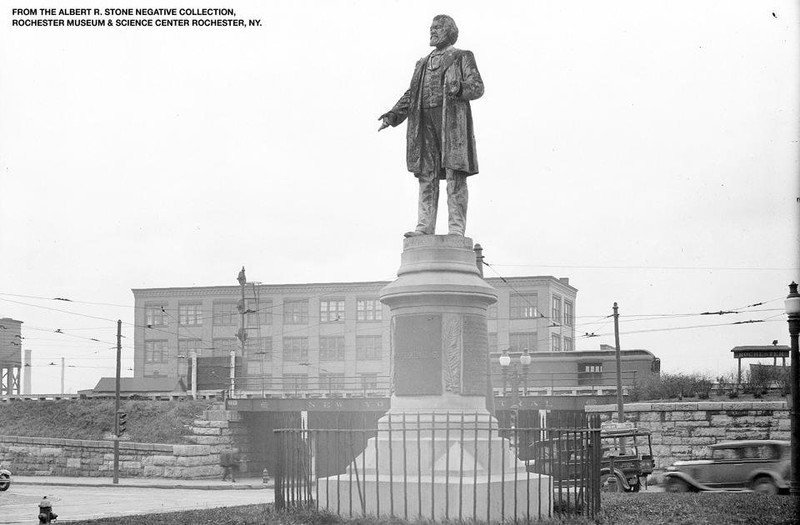Frederick Douglass Monument Unveiled Site
Introduction
Text-to-speech Audio
Images
Frederick Douglass Monument Unveiled Site on the corner of the Central Avenue and St. Paul

Backstory and Context
Text-to-speech Audio
The Frederick Douglass Monument was dedicated to the City of Rochester here, near the train station on the corner of St. Paul and Central Avenue, which was where the monument was unveiled and celebrated in 1899. The original date for unveiling the monument was on September 15th, 1898, however, due to a delay in delivering the statue, only a part of the planned event took place.
The actual unveiling date was on June 9th, 1899, at which Governor Theodore Roosevelt delivered an address. The monument remained near the railroad from1899 -1941, until the Rochester officials decided the noisy and grimy train station was not fitting for one of the city's most respected residents. They then moved the monument to its new location in Highland Park (also known as the Highland Bowl).
The corner of St. Paul and Central Avenue was once marked "the great portal" of the Flower City, because it gave Frederick Douglass's statue a hospitable home, as well as welcoming everyone who was searching for equality. Around ten thousand people were at the site celebrating the unveiling of the monument. This unveiling ceremony was so important that the mayor requested businesses close. He specifically said that after 12 o'clock noon, all business should be suspended as much as possible.
Frederick Douglass's son Charles R. Douglass was the actual model for the statue. The 8-foot tall monument was made by Smith Granite Works of Westerly, Rhode Island, specially commissioned and created by the sculptor Stanley W. Edwards. It cost $7,000, and the city was only able to pay $5,250, after which they were in debt for the remaining $1,750. People came together and donated to the Douglass Monument Committee to help pay off the debt. The monument itself was made out of Bronze, and the pedestal underneath was made out of granite.
This entry is part of a public history project developed by the RIT Museum Studies program in celebration of the bicentennial of Frederick Douglass’s birth (February 1818).The Photo shown in this entry is from the Democrat and Chronicle. See http://media.democratandchronicle.com/retrofitting-rochester/frederick-douglass-monument
Sources
Morry, Emily. Frederick Douglass Monument. Democrat and Chronicle.0 n.d., 2/6/18. http://media.democratandchronicle.com/retrofitting-rochester/fredess-monument.
Rivers, Tom. New York: Frederick Douglass Monument in Rochester First in U.S. to memorialize African American. Orleans Club. Jan. 22nd 2017. Feb 8th 2018. https://orleanshub.com/statuesque-new-york-frederick-douglass-monument-in-rochester-first-in-u-s-to-....
